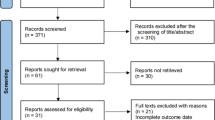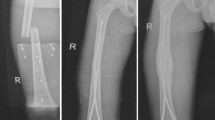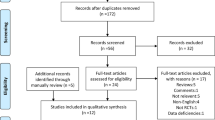Abstract
Femoral shaft fractures in children account for approximately 1.6% of all fractures. These fractures can be treated both operatively and non-operatively. Surgical fixation is more common in the age group above 6 years. Elastic intramedullary nails have become the most popular surgical modality of treatment over the last few decades. However, there is continuous debate about which type of elastic nails (titanium and stainless steel) provides better clinical outcomes with less complication. The main purpose of this study was to systematically search for and critically appraise articles comparing clinical outcomes and complications of titanium elastic nail system (TENS) and stainless steel elastic nail system (SSENS) in management of femoral fractures in the paediatric age group. A comprehensive search of MEDLINE, EMBASE, and Cochrane library databases was performed using specific search terms and limits. Applying strict eligibility criteria, the identified studies were screened. Five studies were identified and reviewed. All of the identified studies were non-randomised comparative studies apart from one randomised controlled study. Studies provide contradictory evidence with regard to time to fracture union and time to full weight bearing. Only one study commented on time to nail removal and found that it is shorter in the TENS group. Two studies showed significantly higher rate of malunion in the TENS group, whereas the rest showed no difference. There was no difference in the rates of delayed union or infection between the two groups and no consistent difference in the rates of skin irritation. Three studies compared Flynn’s outcome score and found no difference apart from one study which found better scores in the SSENS group. There is no consistent evidence to indicate the advantage of one type of elastic nails over the other in management of paediatric femoral shaft fractures; however, the overall trend is in favour of SSENS especially being cheaper than TENS. Critical appraisal of the studies identified significant methodological deficiencies, and further prospective randomised trials are recommended for more potent evidence.

Similar content being viewed by others
References
Kasser JR, Beaty JH (2006) Femoral shaft fractures. In: Kasser JR, Beaty JH (eds) Rockwood & Wilkins’ fractures in children, 6th edn. Lippincott Williams & Wilkins, Philadelphia, pp 894–936
Nafei A, Teichert G, Mikkelson SS, Hvid I (1992) Femoral shaft fractures in children: an epidemiological study in a Danish urban population, 1977–86. J Pediatr Orthop 12(4):499–502
Henderson J, Goldacre MJ, Fairweather JM, Marcovitch H (1992) Conditions accounting for substantial time spent in hospital in children aged 1–14 years. Arch Dis Child 67(1):83–86
Anglen JO, Choi L (2005) Treatment options in paediatric femoral shaft fractures. J Orthop Trauma 19:724–733
Gardner MJ, Lawrence BD, Griffith MH (2004) Surgical treatment of paediatric femoral shaft fractures. Curr Opin Pediatr 16:51–57
Irani RN, Nicholson JT, Chung SM (1976) Long-term results in the treatment of femoral-shaft fractures in young children by immediate spica immobilization. J Bone Joint Surg Am 58(7):945–951
Sugi M, Cole WG (1987) Early plaster treatment for fractures of the femoral shaft in childhood. J Bone Joint Surg Br 69(5):743–745
Czertak DJ, Hennrikus WL (1999) The treatment of paediatric femur fractures with early 90-90 spica casting. J Pediatr Orthop 19(2):229–232
van Tets WF, van der Werken C (1991) External fixation for diaphyseal femoral fractures: a benefit to the young child? Injury 23:162–164
Hughes BF, Sponseller PD, Thompson JD (1995) Paediatric femur fractures: effects of spica cast treatment on family and community. J Pediatr Orthop 15:457–460
Stans AA, Morrissy RT, Renwick SE (1999) Femoral shaft fractures treatment in patients aged 6 to 16 years. J Pediatr Orthop 19:222–238
Narayanan UG, Hyman JE, Wainwright AM, Rang M, Alman BA (2004) Complications of elastic stable intramedullary nail fixation of paediatric femoral fractures, and how to avoid them. J Pediatr Orthop 24(4):363–369
Kanlic EM, Anglen JO, Smith DG, Morgan SJ, Pesantez RF (2004) Advantages of sub muscular bridge plating for complex paediatric femur fractures. Clin Orthop Relat Res 426:244–251
Kanellopoulos AD, Yiannakopoulos CK, Soucaos PN (2006) Closed, locked intramedullary nailing of paediatric femoral shaft fractures through the tip of the greater trochanter. J Trauma 60:217–222
Ligier JN, Metaizeau JP, Prevot J, Lascombes P (1988) Elastic stable intramedullary nailing of femoral shaft fractures in children. J Bone Joint Surg Brit 70(1):74–77
Flynn JM, Hresko T, Reynolds RAK, Blasier D, Davidson R, Kasser J (2001) Titanium elastic nails for paediatric femur fractures: a multicentre study of early results with analysis of complications. J Pediatr Orthop 21:4–8
Narayanan UG, Hyman JE, Wainwright AM, Rand M, Alman BA (2004) Complications of elastic stable intramedullary nail fixation of paediatric femoral fractures, and how to avoid them. J Pediatr Orthop 24:363–369
Flynn JM, Luedtke LM, Ganley TJ et al (2004) Comparison of titanium elastic nails with traction and a spica cast to treat femoral fractures in children. J Bone Joint Surg 86:770–777
Aronson J, Tursky EA (1992) External fixation of femur fractures in children. J Pediatr Orthop 12:157–163
Blasier RD, Aronson J, Tursky EA (1997) External fixation of paediatric femur fractures. J Pediatr Orthop 17:342–346
Gordon JE, Swenning TA, Burd TA, Szymanski DA, Schoenecker PL (2003) Proximal femoral radiographic changes after lateral trans trochanteric intramedullary nail placement in children. J Bone Joint Surg (A) 85:1295–1301
Carmichael KD, Bynum J, Goucher N (2005) Rates of refracture associated with external fixation in paediatric femur fractures. Am J Orthop 34:439–444
Rush LV (1951) Dynamic factors in medullary pinning of fractures. Am Surg 17:803–808
Ehder HG (1975) Treatment of per and subtrochanteric fractures in old age using elastic nails. Hefte Unfallheilkd 121:67–71 (German)
Herscovici D Jr, Scott DM, Behrens F (1992) Nelson B, Benton J. The use of Ender nails in femoral shaft fractures: what are the remaining indications? J Orthop Trauma 6:314–317
Fein LH, Pankovich AM, Spero CM, Baruch HM (1989) Closed flexible intramedullary nailing of adolescent femoral shaft fractures. J Orthop Trauma 3:133–141
Karaoglu S, Baktir A, Tuncel M, Karakag ES, Sakir TM (1994) Closed Ender nailing of adolescent femoral shaft fractures. Injury 25:501–506
Hunter JB (2005) The principles of elastic stable intramedullary nailing in children. Injury 36(1):A20–A24
Pofiler OE (2000) Unalloyed titanium for implants in bone surgery. Injury 31(4):7–13
Uhlhoff HK, Bardos DI, Liskova-Kiar M (1981) The advantages of titanium alloy over stainless steel plates for the internal fixation of fractures. An experimental study in dogs. J Bone Joint Surg Br 63:427–484
Skripitz R, Aspenberg P (1998) Tensile bond between bone and titanium: a reappraisal of osseo-integration. Acta Orthop Scand 69:315–319
Disegi JA (2000) Titanium alloys for fracture fixation implants. Injury 31(4):14–17
Mahar AT, Lee SS, Lalonde FD, Impelluso T, Newton PO (2004) Biomechanical comparison of stainless steel and titanium nails for fixation of simulated femoral fractures. J Pediatr Orthop 24:638–641
Mani US, Satiatino CT, Sabharwai S, Svach DJ, Susiak A, Betirens FF (2006) Biomechanical comparison of flexible stainless steel and titanium nails with external fixation using a femur fracture model. J Pediatr Orthop 26:182–187
Wall EJ, Jain V, Vora V, Mehlman CT, Crawford AH (2008) Complications of titanium and stainless steel elastic nail fixation of paediatric femoral fractures. J Bone Joint Surg Am 90:1305–1313
Khazzam M, Tassone C, Liu XC, Lyon R, Freeto B, Schwab J, Thometz J (2009) Use of flexible intramedullary nail fixation in treating femur fractures in children. Am J Orthop 38:49–55
Lohiya R, Bachhal V, Khan U, Kumar D, Vijayvargiya V, Sankhala SS et al (2011) Flexible intramedullary nailing in paediatric femoral fractures. A report of 73 cases. J Orthop Surg Res 6:64
Balakumar B, Natarajan MV (2013) Is there a role for Ender’s nailing of paediatric femoral fractures in a resource-restricted hospital set-up? J Pediatr Orthop B 22(2):101–105
Goyal N, Aggarwal AN, Mishra P, Jain A (2014) Randomized controlled trial comparing stabilization of fresh close femoral shaft fractures in children with titanium elastic nail system versus stainless steel elastic nail system. Acta Orthop Belg 80(1):69–75
Guyatt G, Sackett D, Cook D (1993) Users’ guides to the medical literature. How to use an article about therapy or prevention. A. Are the results of the study valid? JAMA 270:2598–2601
Colville-Stewart S (2002) How to do a literature search. The essential researcher’s handbook for healthcare professionals, 2nd edn. Bailliere Tindall, London, pp 35–53
Author information
Authors and Affiliations
Corresponding author
Ethics declarations
Conflict of interest
None.
Rights and permissions
About this article
Cite this article
Mohamed, A., Rajeev, A.S. Clinical outcomes and complications of titanium versus stainless steel elastic nail in management of paediatric femoral fractures—a systematic review. Eur J Orthop Surg Traumatol 27, 157–167 (2017). https://doi.org/10.1007/s00590-016-1880-x
Received:
Accepted:
Published:
Issue Date:
DOI: https://doi.org/10.1007/s00590-016-1880-x




